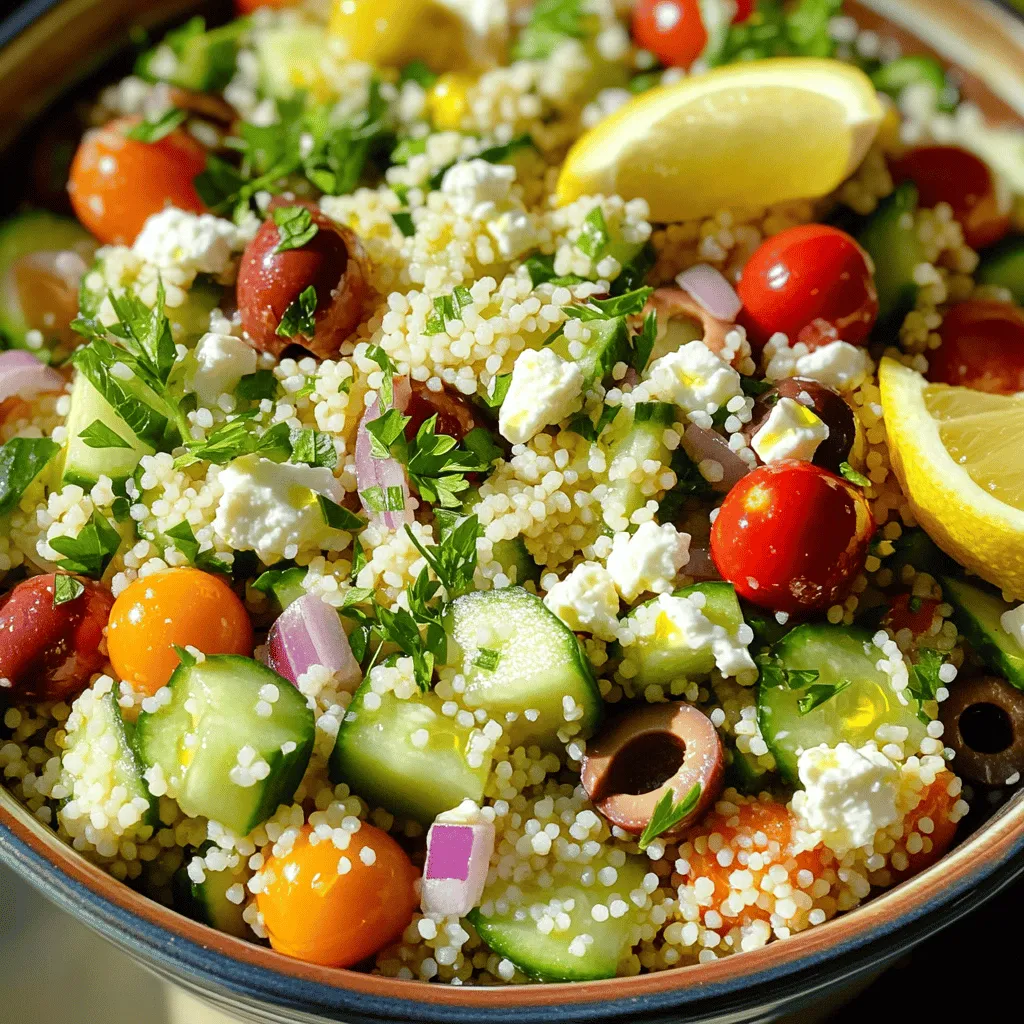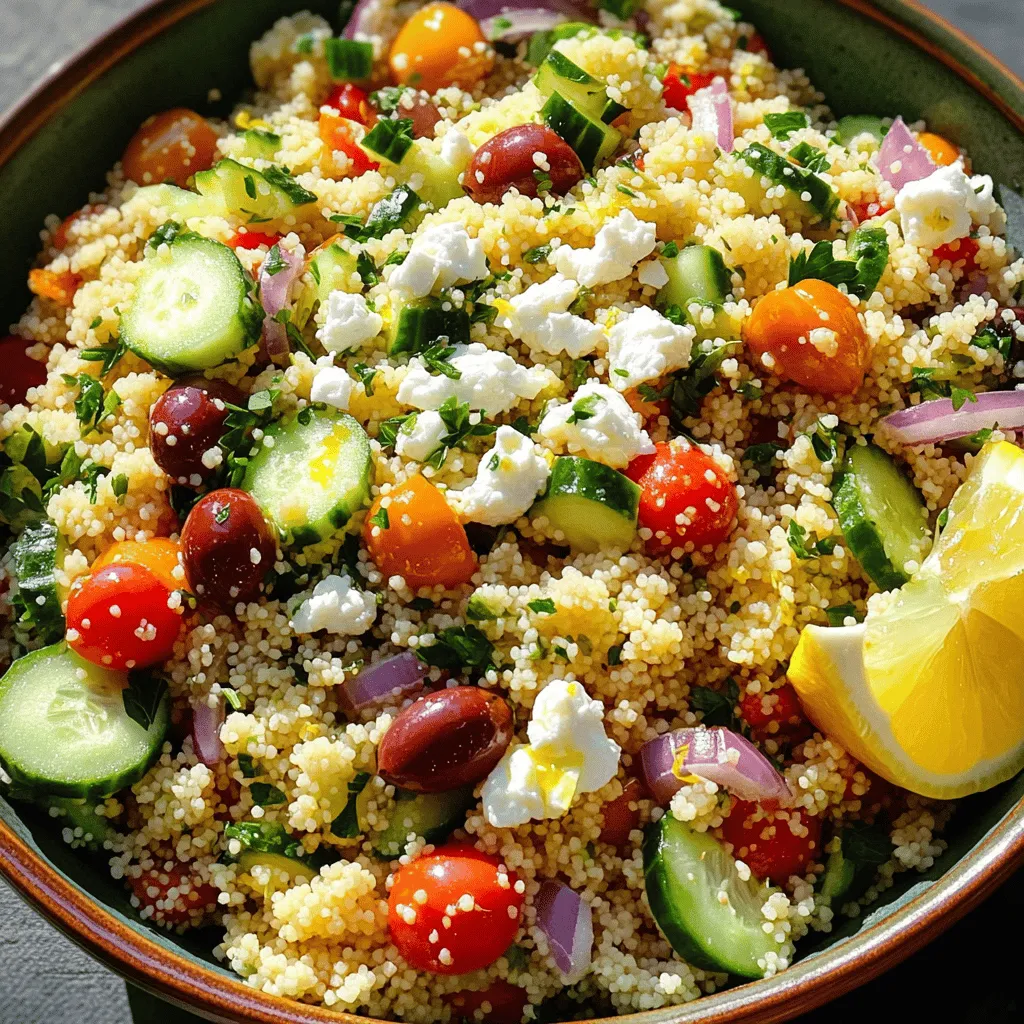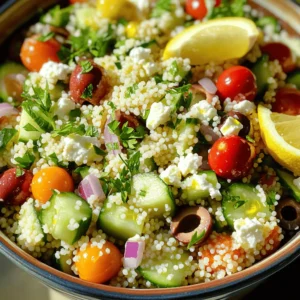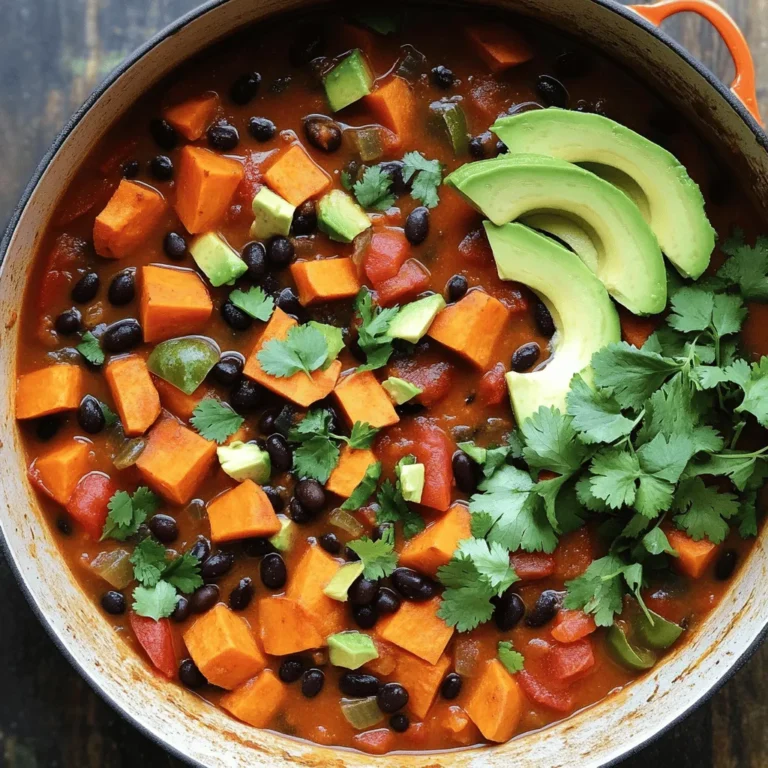Lemon Herb Mediterranean Couscous Flavorful Delight

If you’re craving a bright, fresh dish that bursts with flavor, you need to try Lemon Herb Mediterranean Couscous. This delightful recipe combines fluffy couscous with vibrant veggies, aromatic herbs, and tangy lemon. It’s perfect for a quick weeknight dinner or a tasty side at gatherings. Follow my simple steps to create a meal that’s sure to impress. Let’s get cooking and brighten your table today!
Ingredients
Essential Ingredients for Lemon Herb Mediterranean Couscous
- 1 cup couscous
- 1 1/4 cups vegetable broth or water
- 1 medium cucumber, diced into small cubes
- 1 cup cherry tomatoes, halved
- 1/2 red onion, finely chopped
- 1/2 cup Kalamata olives, pitted and sliced
- 1/2 cup feta cheese, crumbled into small pieces
- 1/4 cup fresh parsley, finely chopped
- 2 tablespoons fresh mint, finely chopped
- Zest and juice of 1 lemon
The heart of this dish is couscous. It cooks fast and is light. Couscous absorbs flavors well. You can use regular or whole wheat couscous. Both options work great.
Next, we have fresh vegetables. The cucumber adds crispness. Cherry tomatoes bring sweetness. Red onion adds a mild bite and color. Kalamata olives give a briny taste that pairs perfectly with the other ingredients.
For herbs and cheese, feta cheese is a must. It adds creaminess and saltiness. Fresh parsley and mint add brightness and aroma. Together, they make the dish fresh and vibrant.
Pantry Staples
- 3 tablespoons extra virgin olive oil
- Salt and freshly ground pepper to taste
- Zest and juice of 1 lemon
Extra virgin olive oil is key for flavor. It coats the couscous and veggies. Salt and pepper enhance all the tastes. A good squeeze of lemon juice adds a zesty kick.
These pantry staples combine with your fresh ingredients. They create a dish that is bright, tasty, and healthy. Each bite will remind you of sunny days by the Mediterranean Sea. Enjoy the process of bringing these flavors together!
Step-by-Step Instructions
Preparing the Couscous
To start, bring 1 1/4 cups of vegetable broth to a boil in a medium pot. Once the broth bubbles, stir in 1 cup of couscous. Remove the pot from heat and cover it with a lid. Let it sit for 5 minutes. This allows the couscous to absorb all the liquid.
After 5 minutes, take a fork and fluff the couscous. This separates the grains and makes it light. Let it cool for a few minutes while you prepare the other ingredients.
Mixing the Ingredients
In a large mixing bowl, combine the diced cucumber, halved cherry tomatoes, finely chopped red onion, and sliced Kalamata olives. Gently mix them together to blend the flavors.
Next, grab a small bowl. Whisk together the lemon zest, lemon juice, extra virgin olive oil, salt, and freshly ground pepper. This dressing adds a zesty kick to the couscous.
Bringing It All Together
Once the couscous has cooled, add it to the bowl with the veggie mixture. Gently toss everything to mix. Ensure the ingredients are well combined.
Now, pour the dressing over the couscous. Toss gently again so every bite gets that zesty flavor.
Finally, fold in the crumbled feta cheese, chopped parsley, and mint. Distribute them evenly throughout the dish. Taste your couscous salad. Adjust the seasoning with more salt, pepper, or lemon juice as needed. Enjoy this bright, fresh dish!
Tips & Tricks
Common Mistakes to Avoid
- Overcooking couscous: Couscous cooks quickly. If you leave it too long, it can become mushy. Stick to the five-minute resting time after boiling. This helps keep the grains fluffy and separate.
- Not cooling couscous before mixing: Make sure to cool the couscous before adding it to your veggies. Hot couscous can wilt fresh ingredients. Let it sit for a few minutes after fluffing.
Flavor Enhancements
- Adding more herbs or spices: To boost the flavor, add extra herbs. Fresh basil or dill can enhance the taste. You can also sprinkle in some red pepper flakes for a kick.
- Adjusting lemon juice for zest: The lemon juice adds brightness. If you want more zing, try adding a bit more juice. You can also use lemon zest to bring out a stronger lemon flavor.

Variations
Ingredient Swaps
You can easily switch out ingredients in this dish. For cheese, consider using goat cheese instead of feta. Goat cheese adds a creamy texture and tangy flavor. This swap makes the dish unique and adds a new taste.
For vegetables, feel free to use bell peppers instead of cucumbers. Bell peppers add crunch and sweet flavor. You can mix colors too. Red, yellow, and green peppers brighten the dish and make it more fun.
Enhancing Nutritional Value
To boost this dish’s nutrition, add protein. Chickpeas work well and give a hearty texture. You can also use grilled chicken for a filling meal. Both options increase protein and keep you satisfied.
Incorporating nuts or seeds adds crunch and healthy fats. Try adding toasted pine nuts or slivered almonds. They give a nice texture and flavor. Plus, they make the dish more interesting.
Feel free to mix and match these ideas. Each swap or addition can change the dish’s taste and health benefits.
Storage Info
Proper Storage Techniques
To keep your Lemon Herb Mediterranean Couscous fresh, store it in an airtight container. This keeps moisture out and helps maintain its flavor. Place the container in the fridge if you plan to save leftovers. It’s best to let the dish cool to room temperature before sealing it up. This prevents condensation buildup inside the container.
Shelf Life
This tasty couscous dish lasts about 3 to 5 days in the fridge. After that, it may start to lose quality. Look for signs of spoilage. If you see mold or an off smell, it’s time to toss it. Always trust your senses when deciding if food is still good. Enjoy this dish while it’s fresh for the best taste!
FAQs
How can I make this dish gluten-free?
To make Lemon Herb Mediterranean Couscous gluten-free, you can swap couscous for quinoa or rice. Both options work well. Quinoa adds protein, while rice gives a nice texture. Be sure to check labels, as some brands may contain gluten.
Can I prepare this recipe ahead of time?
Yes, you can prepare this recipe ahead of time. Make the couscous and mix the veggies. Store them in separate containers. This keeps everything fresh. Mix them together just before serving. This way, the flavors stay bright.
What can I serve with Lemon Herb Mediterranean Couscous?
Lemon Herb Mediterranean Couscous pairs well with many dishes. Grilled chicken or fish complements the flavors nicely. You can also serve it with roasted vegetables or a fresh salad. These options add great texture and taste.
Is this recipe suitable for meal prepping?
This recipe is great for meal prepping. Store portions in airtight containers. Keep it in the fridge for up to three days. To reheat, use a microwave or a skillet. Add a splash of olive oil for flavor.
In this post, we explored how to make Lemon Herb Mediterranean Couscous. We covered the key ingredients, from couscous and fresh veggies to herbs and cheese. I outlined easy steps to prepare, mix, and bring it all together for great flavor.
With some tips on avoiding common mistakes and fun variations, you can make this dish your own. Remember to store leftovers properly for the best taste. Enjoy your culinary adventure with this delicious and healthy meal!



![To make Honey Mustard Chicken Thighs, you need simple, fresh ingredients. Here’s what you will need: - 4 bone-in chicken thighs, skin-on - 1/4 cup honey - 1/4 cup Dijon mustard - 2 tablespoons olive oil - 3 cloves garlic, minced - 1 teaspoon dried thyme - 1 teaspoon paprika - Salt and black pepper to taste - Fresh parsley for garnish These ingredients bring great flavor to your meal. The honey adds sweetness, while the Dijon mustard gives it a nice tang. Olive oil keeps the chicken juicy, and garlic boosts the taste. Dried thyme and paprika add depth, making every bite delicious. Don’t forget the parsley! It makes your dish look pretty and fresh. This recipe is quick and easy, perfect for any night. For the full instructions, check the Full Recipe. First, preheat your oven to 400°F (200°C). This heat will cook your chicken just right. In a small bowl, whisk together these ingredients: - 1/4 cup honey - 1/4 cup Dijon mustard - 2 tablespoons olive oil - 3 cloves garlic, minced - 1 teaspoon dried thyme - 1 teaspoon paprika - Salt and black pepper to taste Make sure to mix well. This creates a smooth and tasty marinade. Next, take your chicken thighs and place them in a large bowl or a resealable bag. Pour the marinade over the chicken. Ensure each piece is coated well. For the best flavor, let it marinate for at least 30 minutes. If you have more time, refrigerating it overnight works wonders. Now, heat a large oven-safe skillet over medium-high heat. Once hot, add the marinated chicken thighs, skin-side down. Sear them for about 5-7 minutes until the skin is golden brown. This step gives the chicken a nice crisp. After that, flip the thighs using tongs. Transfer the skillet to your preheated oven. Bake for 25-30 minutes. Check that the internal temperature reaches 165°F (75°C). If the juices run clear, the chicken is done. Once cooked, take the skillet from the oven and let the chicken rest for 5 minutes. This helps keep it juicy. Before serving, sprinkle some fresh parsley on top for a lovely finish. For the complete recipe, don't forget to check the [Full Recipe]. To get the best flavor, marinate the chicken thighs well. Use a large bowl or a resealable plastic bag for this. After mixing the marinade, pour it over the chicken. Make sure each piece is coated. For great results, let the chicken sit in the marinade for at least 30 minutes. You can also refrigerate it overnight. This extra time helps the flavors soak in deep. Cooking chicken thighs at the right temperature is key. Preheat your oven to 400°F (200°C). This hot oven cooks the chicken evenly and keeps it juicy. After searing the chicken for 5-7 minutes on the stovetop, transfer it to the oven. Bake for 25-30 minutes. Check the chicken's internal temperature. It should reach 165°F (75°C) for safe eating. Let it rest for 5 minutes before serving, which helps keep it moist. When serving, presentation matters. Place the chicken thighs on a white platter or a wooden board. Drizzle any leftover marinade over the top for added flavor. Garnish with fresh parsley for a pop of color. This simple touch makes the dish look more inviting. You can pair the chicken with roasted veggies or a fresh salad. These sides complement the sweet and tangy flavors of the honey mustard. For the full recipe, check out the details above. {{image_4}} You can change the sauce to fit your taste. Try using maple syrup instead of honey. This gives a unique sweetness. You can also mix in some soy sauce for a savory twist. If you like heat, add a dash of hot sauce or cayenne pepper. For a tangy flavor, consider apple cider vinegar. Each option adds a new layer to the dish. While chicken thighs are great, you can also use chicken breasts. They cook faster but stay moist if cooked right. Drumsticks are another option. They have lots of flavor and a nice crisp skin. You can even use a whole chicken, just adjust cooking time. Each cut brings its own charm to the recipe. For a full meal, add vegetables. Root veggies like carrots and potatoes roast well. Toss them in the marinade for extra flavor. You can also use green beans or broccoli. Place them in the skillet with the chicken. They will soak up the sauce and cook perfectly. This way, you have a tasty one-pan meal that's easy to serve. For the full recipe, check out the previous section. After cooking, let the chicken cool down. Place the chicken thighs in an airtight container. Store them in the fridge for up to three days. Make sure the temperature stays below 40°F (4°C). This keeps your chicken safe and tasty. If you want to store the chicken longer, freezing is a great option. Wrap each thigh tightly in plastic wrap. Then put them in a freezer-safe bag. You can freeze them for up to three months. Remember to label the bag with the date. When you are ready to enjoy leftovers, preheat your oven to 350°F (175°C). Place the chicken in a baking dish. Cover it with foil to keep it moist. Heat for about 20-25 minutes. You can also use a microwave, but it may dry the chicken out. For the best taste, the oven is the way to go. Enjoy your meal again! You should marinate honey mustard chicken thighs for at least 30 minutes. This allows the flavors to soak into the meat. If you have time, marinating overnight works even better. It deepens the taste and makes the chicken more tender. Yes, you can use boneless chicken thighs. They cook faster than bone-in thighs. Adjust the cooking time to about 20-25 minutes in the oven. Always check that the internal temperature reaches 165°F (75°C) for safety. Honey mustard chicken thighs pair well with many sides. Here are some ideas: - Steamed vegetables: Broccoli or green beans add color. - Rice or quinoa: Both soak up the sauce nicely. - Salad: A fresh green salad balances the meal. - Mashed potatoes: Creamy potatoes are a great comfort food option. You can find the full recipe to help you create this delicious meal. In this post, I shared ingredients and steps for making honey mustard chicken thighs. I provided tips for marinating and cooking this dish to enhance its flavor. You learned about variations and how to store leftovers properly. Remember, simple changes can make a big impact on taste. I encourage you to try these ideas for yourself. Enjoy cooking and delight in every bite!](https://dishtreats.com/wp-content/uploads/2025/06/0b4fb8df-5400-4b6b-9acb-490ad2d6fca7-768x768.webp)



